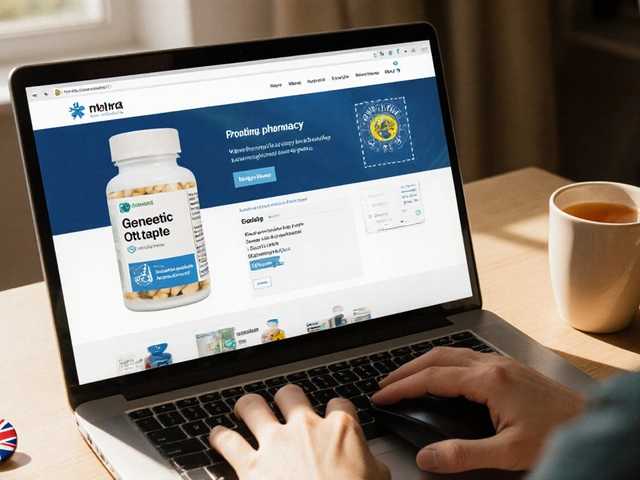Antihypertensive Medication Selector
Fill out the form below to get personalized medication recommendations based on your patient's condition.
Hydrochlorothiazide is a thiazide diuretic prescribed to lower high blood pressure and treat fluid retention. It works by promoting sodium and water excretion through the kidneys, which reduces blood volume and eases the heart's workload.
Quick Takeaways
- Hydrochlorothiazide (HCTZ) is cheap, widely available, and effective for mild‑to‑moderate hypertension.
- Thiazide‑like drugs such as chlortalidone and indapamide often provide longer‑lasting control.
- Loop diuretics (e.g., furosemide) are stronger but suited for edema rather than primary BP control.
- Potassium‑sparing agents (spironolactone) or RAAS blockers (lisinopril, losartan) are useful when HCTZ causes low potassium or when kidney disease is present.
- Choosing the right drug depends on kidney function, electrolyte balance, and co‑existing conditions like diabetes or gout.
How Hydrochlorothiazide Works
HCTZ blocks the Na⁺/Cl⁻ cotransporter in the distal convoluted tubule. By reducing sodium reabsorption, it forces the body to lose both sodium and water. The resulting dip in circulating volume gently lowers systolic and diastolic pressures, typically by 5‑10mmHg.
Who Should Take Hydrochlorothiazide?
Ideal candidates are adults with stage1‑2 hypertension, especially those without chronic kidney disease (CKD) or baseline low potassium. It’s also a first‑line choice for patients needing a simple once‑daily pill.
Typical Dosing and Safety Profile
Standard adult dosing starts at 12.5mg once daily, often titrated to 25mg. The drug is absorbed quickly, reaching peak levels in about 2hours. Common side effects include increased urination, mild dizziness, and electrolyte shifts-most notably potassium loss.
Key Alternatives to Hydrochlorothiazide
Below are the most frequently considered substitutes, grouped by therapeutic class.
Chlortalidone is a long‑acting thiazide‑like diuretic often preferred for its sustained blood‑pressure reduction.
Indapamide is a thiazide‑like diuretic that provides steady BP control with a lower risk of potassium loss.
Furosemide is a loop diuretic used for rapid fluid removal in heart failure or severe edema.
Spironolactone is a potassium‑sparing diuretic that blocks aldosterone, useful when HCTZ causes hypokalemia.
Lisinopril is an ACE inhibitor that lowers BP by preventing angiotensin‑II formation.
Losartan is an angiotensin‑II receptor blocker (ARB) that offers similar benefits to ACE inhibitors without cough.
Atenolol is a beta‑blocker that reduces heart rate and cardiac output, often added in resistant hypertension.

Side‑Effect Snapshot Across Alternatives
Understanding the trade‑offs helps avoid unwanted lab results or symptoms.
| Drug | Class | Typical Daily Dose | Main Side Effects | Best For |
|---|---|---|---|---|
| Hydrochlorothiazide | Thiazide diuretic | 12.5‑25mg | Low potassium, mild hyperuricemia, photosensitivity | Simple hypertension, cost‑sensitive patients |
| Chlortalidone | Thiazide‑like diuretic | 12.5‑25mg | Less potassium loss, possible hyponatremia | Patients needing longer‑acting control |
| Indapamide | Thiazide‑like diuretic | 1.5‑2.5mg | Very low potassium impact, mild headache | Those with borderline low potassium |
| Furosemide | Loop diuretic | 20‑80mg | Significant potassium loss, ototoxicity at high doses | Edema, congestive heart failure |
| Spironolactone | Potassium‑sparing | 25‑100mg | Hyperkalemia, breast tenderness (women) | Hypokalemia from thiazides, resistant hypertension |
| Lisinopril | ACE inhibitor | 10‑40mg | Cough, angioedema, elevated potassium | Patients with diabetic kidney disease |
| Losartan | ARB | 50‑100mg | Dizziness, less cough, possible hyperkalemia | ACE‑inhibitor intolerant patients |
| Atenolol | Beta‑blocker | 25‑100mg | Fatigue, cold extremities, bradycardia | Patients with coronary artery disease |
Decision Criteria: When to Stick with Hydrochlorothiazide
- Cost and access - Generic HCTZ is often the cheapest antihypertensive.
- Kidney function - If eGFR >30mL/min, HCTZ works well; below that, consider chlortalidone or a RAAS blocker.
- Electrolyte profile - Patients with baseline low potassium may need a potassium‑sparing add‑on or a thiazide‑like alternative.
- Co‑existing gout - HCTZ raises uric acid; indapamide or a non‑diuretic class may be better.
- Diabetes risk - Thiazides can raise glucose; ACE inhibitors or ARBs offer protective effects.
Putting It All Together: A Simple Selection Flow
- Confirm blood pressure level and target organ risk.
- Check renal function (eGFR) and serum potassium.
- If eGFR >30mL/min and potassium is normal, start Hydrochlorothiazide.
- If potassium low or gout present, consider Indapamide or add Spironolactone.
- If eGFR <30mL/min, skip thiazides; choose Lisinopril or Losartan.
- For persistent edema, switch or add Furosemide.
- Re‑assess BP after 4‑6 weeks; adjust dose or add a second agent if needed.
Related Concepts Worth Knowing
Understanding the surrounding physiology helps explain why drugs differ.
- Sodium intake - Reducing dietary salt amplifies the effect of any diuretic.
- Renin‑angiotensin‑aldosterone system (RAAS) - RAAS blockers complement diuretics by preventing rebound sodium retention.
- Serum potassium monitoring - Essential when using thiazides or loop diuretics.
- Uric acid levels - Important for patients with a history of gout; thiazides can exacerbate attacks.
- Glucose metabolism - Thiazides may modestly raise fasting glucose; consider in diabetic patients.
Next Steps and Monitoring Tips
- Schedule a follow‑up BP check 4 weeks after initiating therapy.
- Order labs: electrolytes, creatinine, uric acid, fasting glucose.
- If potassium drops below 3.5mmol/L, add a potassium‑rich food plan or a sparing agent.
- Educate patients to report muscle cramps, dizziness, or sudden weight gain.
Frequently Asked Questions
Is Hydrochlorothiazide safe for long‑term use?
Yes, when monitored regularly. Long‑term safety hinges on checking kidney function and electrolytes every 3-6 months. Most patients stay on a low dose without serious issues.
How does Hydrochlorothiazide compare to Chlortalidone?
Both are thiazide‑type diuretics, but chlortalidone has a longer half‑life, providing steadier blood‑pressure control over 24hours. It may be preferred for patients who miss doses or need tighter control.
Can I combine Hydrochlorothiazide with an ACE inhibitor?
Absolutely. The combo is common because the ACE inhibitor counteracts the potassium‑lowering effect of HCTZ and improves overall BP reduction.
Why does Hydrochlorothiazide raise uric acid?
Thiazides reduce renal clearance of uric acid, leading to higher serum levels. In gout‑prone patients, an alternative diuretic or a urate‑lowering drug may be needed.
What should I do if I develop a dry cough on Lisinopril?
Switch to an ARB like losartan. ARBs block the same pathway without triggering the cough that ACE inhibitors sometimes cause.








Annette Smith
September 25, 2025 AT 23:05I often think about the balance between efficacy and side‑effects when choosing a blood pressure med. Hydrochlorothiazide is cheap and works for many, but its impact on potassium can be tricky. In patients with borderline kidney function, a thiazide‑like agent may do more harm than good. Switching to an ACE inhibitor or ARB can smooth out those electrolyte swings. It all comes down to the individual profile, not just the pill name.
beth shell
September 26, 2025 AT 11:46Reflecting on that, simplicity matters. A drug that is easy to monitor wins. Yet we must respect the body’s signals.
khushali kothari
September 27, 2025 AT 04:26The comparative pharmacodynamics of HCTZ versus calcium‑channel blockers reveal distinct natriuretic profiles. In patients with reduced eGFR, thiazide diuretics exhibit diminished efficacy due to altered tubular handling of sodium. Moreover, hyperuricemia risk escalates in gout‑prone individuals, necessitating alternative agents such as losartan. From a mechanistic standpoint, ACE inhibitors confer renoprotective benefits via modulation of intraglomerular pressure. Therefore, algorithmic selection should integrate renal metrics, potassium indices, and comorbid metabolic parameters.
Kelvin Van der Maelen
September 27, 2025 AT 05:50Wow, that sounded like a lecture! In plain speak, HCTZ is cheap but can mess with your kidneys and potassium. If your labs are shaky, think twice before picking it.
Brian Koehler
September 27, 2025 AT 21:06Great points, everyone!; let's remember that patient education is key,; adherence improves when we explain the why behind each choice,; and clinicians should tailor therapy based on real‑world data,; especially in diverse populations where genetics and diet interact with drug metabolism,; so keep the conversation open and supportive!
Dominique Lemieux
September 29, 2025 AT 00:53When one steps into the labyrinth of antihypertensive therapeutics, one quickly discovers that the simplicity of a single‑pill regimen belies a cascade of physiological reverberations. Hydrochlorothiazide, a thiazide diuretic, exerts its natriuretic effect by inhibiting the Na‑Cl symporter in the distal convoluted tubule, thereby reducing plasma volume and peripheral resistance. Yet, this very mechanism precipitates hypokalemia, hyperuricemia, and, in susceptible individuals, an exacerbation of gouty arthritis. In contrast, an angiotensin‑converting enzyme inhibitor operates upstream, attenuating the renin‑angiotensin‑aldosterone system, which not only lowers blood pressure but also confers renal protective effects. The calcium‑channel blockers, meanwhile, induce vasodilation through inhibition of L‑type calcium channels, a pathway that sidesteps many electrolyte disturbances. The clinician must weigh these pharmacodynamic nuances against patient‑specific factors such as estimated glomerular filtration rate, baseline potassium, and comorbid diabetes. Evidence suggests that in patients with chronic kidney disease, ACE inhibitors or ARBs reduce the progression of proteinuria more effectively than thiazides. Moreover, the risk of metabolic side‑effects, including dysglycemia, is lower with certain ARBs compared to diuretic therapy. If the therapeutic goal includes mitigation of cardiovascular remodeling, beta‑blockers may hold an advantage, though they lack the diuretic's ability to address volume overload in heart failure. On the other hand, combination therapy-pairing a low‑dose thiazide with an ACE inhibitor-can harness synergistic benefits while tempering adverse electrolyte shifts. It is also worth noting that patient adherence often improves when dosing frequency is minimized, a factor that favors agents with longer half‑lives. Yet, the economics of care cannot be ignored; hydrochlorothiazide remains a cost‑effective option, particularly in resource‑limited settings. Ultimately, the art of prescribing lies in balancing efficacy, safety, cost, and patient preference, while staying vigilant for laboratory trends that may herald impending complications. Continuous monitoring of serum potassium, creatinine, and uric acid is indispensable, regardless of the chosen regimen. In sum, there is no universal champion; the optimal agent is the one that harmonizes with the individual’s clinical tapestry.
Laura MacEachern
September 29, 2025 AT 02:16Love how you laid it out! Remember that staying positive with patients encourages them to stick with the plan. If you spot an electrolyte dip early, a quick tweak can keep the whole regimen on track.
BJ Anderson
September 30, 2025 AT 04:40Honestly, the drama of picking the “right” pill can feel like a soap opera. You want the dramatic reduction in numbers without the side‑effects stealing the spotlight. Balance is key.
Aparna Dheep
October 1, 2025 AT 08:26One must recognize the intellectual elitism embedded in the routine prescription of hydrochlorothiazide. It masquerades as simplicity while concealing a cascade of metabolic perturbations...– subtle, yet profound. In our modern therapeutic discourse, we ought to challenge this complacency. The casual clinician often overlooks the nuanced interplay of electrolytes and comorbidities.
Nicole Powell
October 1, 2025 AT 11:13Clearly, not every drug is a universal panacea.
Ananthu Selvan
October 2, 2025 AT 12:13HCTZ? Overrated. Pick something that actually works without the hype.
Nicole Chabot
October 3, 2025 AT 16:00It’s fascinating how a simple lab value can guide such a pivotal decision. I appreciate the thorough breakdown and feel more confident navigating these choices in practice.
Sandra Maurais
October 4, 2025 AT 19:46From a clinical governance perspective, the data presented aligns with current guidelines. Please ensure regular monitoring; patient safety remains paramount. 👍